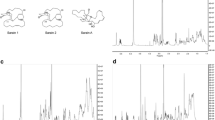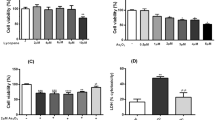Abstract
Shikimic acid (SA), originally extracted from Illicium verum Hook. fil., is an indispensable starting material for the synthesis of the antiviral drug Oseltamivir (Tamiflu®) with very limited number of studies regarding its biological effects in vitro. Therefore, we here evaluated the thermoanalytical profile, redox properties, and in vitro effects of SA on human neuronal-like cells (SH-SY5Y). The thermoanalytical profile of SA was studied by using differential scanning calorimetry (DSC) and thermogravimetry/derivative thermogravimetry (TG/DTG) characterization. Both antioxidant potential and in vitro lipoperoxidation levels were analyzed. Cell viability and intracellular reactive species (RS) production was determined by DCF and SRB assays, respectively. Our results show in vitro antioxidant activity of SA without exerting cytotoxic effects on SH-SY5Y cells at tested concentrations of 10 nM, 10 μM, and 10 mM. In addition, SA protected the cells against H2O2-induced toxicity; effect that could be related, at least in part, with decreased intracellular RS production and its antioxidant potential. The present study shows evidence for neuroprotective actions of SA against oxidative stress-induced toxicity on SH-SY5Y cells, inviting for further investigation about its potential use in the context of oxidative stress-associated neurodegenerative diseases.







Similar content being viewed by others
References
Aebi H (1984) Catalase in vitro. Methods Enzymol 105:121–126
Araújo AAS, Storpirtis S et al (2003) Thermal analysis of the antiretroviral zidovudine (AZT) and evaluation of the compatibility with excipients used in solid dosage forms. Int J Pharm 260(2):303–314
Barak V, Halperin T et al (2001) The effect of Sambucol, a black elderberry-based, natural product, on the production of human cytokines: I. Inflammatory cytokines. Eur Cytokine Netw 12(2):290–296
Benmalek Y, Yahia OA et al (2013) Anti-microbial and anti-oxidant activities of Illicium verum, Crataegus oxyacantha ssp monogyna and Allium cepa red and white varieties. Bioengineered 4(4):244–248
Bertelli AA, Giovannini L et al (1996) Antiplatelet activity of cis-resveratrol. Drugs Exp Clin Res 22(2):61–63
Bertelli AA, Mannari C et al (2008) Immunomodulatory activity of shikimic acid and quercitin in comparison with oseltamivir (Tamiflu) in an in vitro model. J Med Virol 80(4):741–745
Bradford MM (1976) A rapid and sensitive method for the quantitation of microgram quantities of protein utilizing the principle of protein-dye binding. Anal Biochem 72:248–254
Cheung Y-T, Lau WK-W et al (2009) Effects of all-trans-retinoic acid on human SH-SY5Y neuroblastoma as in vitro model in neurotoxicity research. NeuroToxicology 30(1):127–135
Coleman WF (2005) Shikimic acid. J Chem Educ 82(4):656
da Frota Junior ML, Pires AS et al (2011) In vitro optimization of retinoic acid-induced neuritogenesis and TH endogenous expression in human SH-SY5Y neuroblastoma cells by the antioxidant Trolox. Mol Cell Biochem 358(1-2):325–334
Draper HH, Hadley M (1990) Malondialdehyde determination as index of lipid peroxidation. Methods Enzymol 186:421–431
Dresch MT, Rossato SB et al (2009) Optimization and validation of an alternative method to evaluate total reactive antioxidant potential. Anal Biochem 385(1):107–114
Ducati RG, Basso LA et al (2007) Mycobacterial shikimate pathway enzymes as targets for drug design. Curr Drug Targets 8(3):423–435
El-Seedi HR, Ringbom T et al (2003) Constituents of Hypericum laricifolium and their cyclooxygenase (COX) enzyme activities. Chem Pharmaceut Bull 51(12):1439–1440
Estevez AM, Estevez RJ (2012) A short overview on the medicinal chemistry of (−)-shikimic acid. Mini Rev Med Chem 12(14):1443–1454
Green LC, Wagner DA et al (1982) Analysis of nitrate, nitrite, and [15N]nitrate in biological fluids. Anal Biochem 126(1):131–138
Halliwell B (2008) Are polyphenols antioxidants or pro-oxidants? What do we learn from cell culture and in vivo studies? Arch Biochem Biophys 476(2):107–112
Halliwell B, Gutteridge JMC (2007) Free radicals in biology and medicine. Oxford University Press, Oxford
Huang FY, Xiu QP et al (2002) Anti-platelet and anti-thrombotic effects of triacetylshikimic acid in rats. J Cardiovasc Pharmacol 39(2):262–270
Itoigawa M, Ito C et al (2004) Cancer chemopreventive activity of phenylpropanoids and phytoquinoids from Illicium plants. Cancer Lett 214(2):165–169
Kamara BI, Brand DJ et al (2004) Phenolic metabolites from honeybush tea (Cyclopia subternata). J Agric Food Chem 52(17):5391–5395
Kramer M, Bongaerts J et al (2003) Metabolic engineering for microbial production of shikimic acid. Metab Eng 5(4):277–283
Lissi E, Pascual C et al (1992) Luminol luminescence induced by 2,2′-azo-bis(2-amidinopropane) thermolysis. Free Radic Res Commun 17(5):299–311
Ma Y, Xu QP et al (1999) Antagonistic effects of shikimic acid against focal cerebral ischemia injury in rats subjected to middle cerebral artery thrombosis. Zhongguo Yao Li Xue Bao 20(8):701–704
Oliveira AP, Valentao P et al (2009) Ficus carica L.: metabolic and biological screening. Food Chem Toxicol 47(11):2841–2846
Pasqua G, Avato P et al (2003) Metabolites in cell suspension cultures, calli, and in vitro regenerated organs of Hypericum perforatum cv. Topas. Plant Sci 165(5):977–982
Paya M, Halliwell B et al (1992) Interactions of a series of coumarins with reactive oxygen species. Scavenging of superoxide, hypochlorous acid and hydroxyl radicals. Biochem Pharmacol 44(2):205–214
Rabelo TK, Zeidán-Chuliá F et al (2012) Redox characterization of usnic acid and its cytotoxic effect on human neuron-like cells (SH-SY5Y). Toxicol In Vitro 26(2):304–314
Rice-Evans CA, Miller NJ et al (1996) Structure-antioxidant activity relationships of flavonoids and phenolic acids. Free Radic Biol Med 20(7):933–956
Tepe B, Sokmen A (2007) Screening of the antioxidative properties and total phenolic contents of three endemic Tanacetum subspecies from Turkish flora. Bioresour Technol 98(16):3076–3079
Vichai V, Kirtikara K (2006) Sulforhodamine B colorimetric assay for cytotoxicity screening. Nat Protoc 1(3):1112–1116
Wang H, Joseph JA (1999) Quantifying cellular oxidative stress by dichlorofluorescein assay using microplate reader. Free Radic Biol Med 27(5-6):612–616
Wojcik A, Podstolski A (2007) Leaf explant response in in vitro culture of St. John’s wort (Hypericum perforatum L.). Acta Physiol Plant 29(2):151–156
Zeidán-Chuliá F, Gelain DP et al (2013) Major components of energy drinks (caffeine, taurine, and guarana) exert cytotoxic effects on human neuronal SH-SY5Y cells by decreasing reactive oxygen species production. Oxid Med Cell Longev 2013:791795
Acknowledgments
The Brazilian agencies FAPERGS (No. 0998120), CNPq (PVE, INCTEN, and IBN-Net programs), CAPES, and PROPESQ-UFRGS supported this work. Fares Zeidán-Chuliá holds a PNPD postdoctoral position (Departamento de Bioquímica, Universidade Federal do Rio Grande do Sul) funded by CAPES.
Conflict of Interest
The authors declare no conflict of interest.
Author information
Authors and Affiliations
Corresponding author
Rights and permissions
About this article
Cite this article
Rabelo, T.K., Zeidán-Chuliá, F., Caregnato, F.F. et al. In Vitro Neuroprotective Effect of Shikimic Acid Against Hydrogen Peroxide-Induced Oxidative Stress. J Mol Neurosci 56, 956–965 (2015). https://doi.org/10.1007/s12031-015-0559-9
Received:
Accepted:
Published:
Issue Date:
DOI: https://doi.org/10.1007/s12031-015-0559-9




